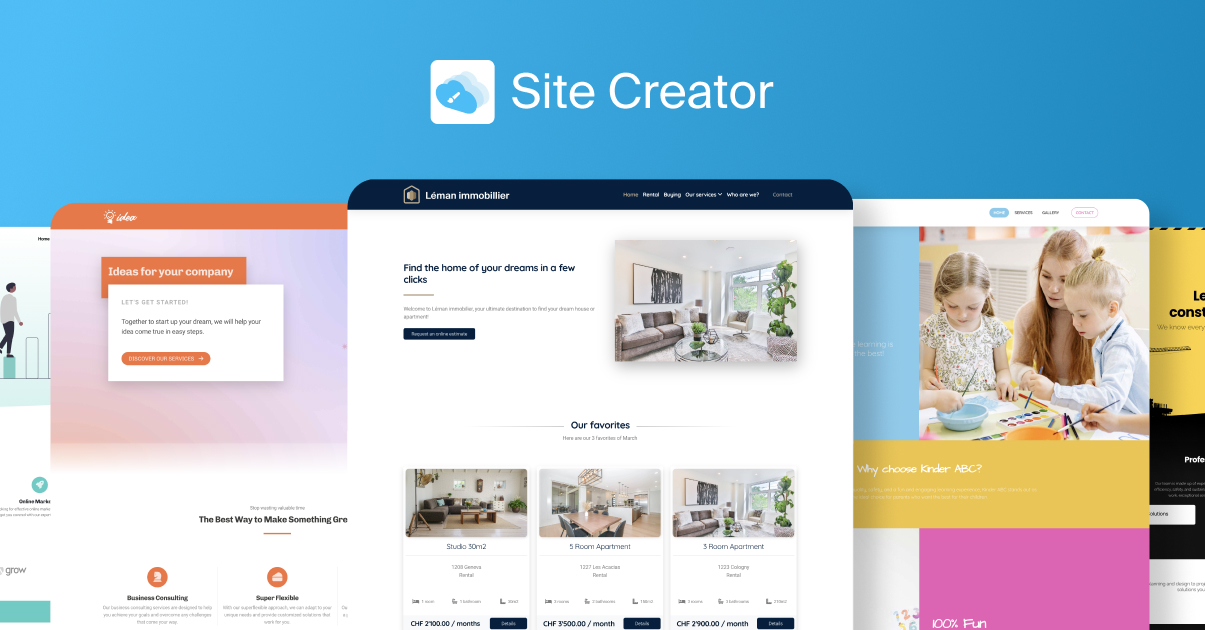This article shares some good recommendations for optimizing a website’s SEO. This SEO guide is provided by Axel Janvier, SEO and SEA consultant with SeoMix, based in Nantes. Axel has been working with SEO for 5 years and has Google Adwords certification.
The goal of a website is to generate traffic
The first goal of a website, in addition to having a good host, like Infomaniak, is to generate traffic. To achieve this goal, search engines like Google and Bing are sources not to be disregarded. So it is essential to have proper referencing in search engines: that’s the whole purpose of search engine optimization (SEO).
However, just being referenced on a search engine is not enough. A site needs to be ranked among the top results, or at least on the first page (in the top 10 spots). In fact, 90% of web users performing a search don’t go past the first page. So, in this guide, we are going to define what search engine optimization really is, and we will then present the basics of SEO, then we will finish by discussing algorithm updates and search engine penalties.
As you read this article, you will learn the main factors that will enable you to get off to a good start in search engine optimization for a website.
Definition of search engine optimization
SEO means optimizing a website to be indexed by search engines.
The principle is simple: your website must be visible in search results when a web user performs a search, e.g., on Google. When they find your website, web users can thus visit it, buy your products, or simply get in contact with you.
Therefore, search engine optimization is a website’s visibility in search engines based on a set of keywords typed by users. In the rest of this guide, we will see what to do in order to be visible in search engines like Google or Bing using search engine optimization.
The basics of search engine optimization
Below you will find 8 detailed recommendations that will enable you to optimize the natural results of a website. These recommendations are an essential basis for acquiring the means to be visible in search engines.
1. Select the keywords on which you want to position your site
The first step, before considering your site’s SEO, will be to choose the keywords you want to be visible. This choice of keywords is important because it will influence the SEO strategy you will employ as the months go by.
To choose your keywords and get an idea of their search volumes, you can use tools like Google Adwords or Ubersuggest. These services give you, on average and by month, the number of times a keyword is typed into Google.
For this to be a bit more concrete, here is an example with a sceenshot of the information from the Google Adwords tool:
On this screenshot, you can see that the keyword, “Adwords” is typed approximately 74,000 times on Google in France.
To choose the right keywords, we recommend proceeding as follows:
- Choosing your generic keywords and defining different themes
- Integrating other keywords into these themes which will compose your secondary keywords
- Each theme should be associated with a single unique primary keyword, and the other keywords must be considered secondary
After selecting your primary and secondary keywords, you will be able to start defining your tree structure and draft the first content. Don’t be surprised if, after publishing content on a site, the Webanalytics solution (Google Analytics, Piwik, etc.) used does not provide the keywords that have generated traffic: they are hidden with what the term “Not Provided” in their place.
2. Facilitating exploration and indexing of your site by Google
The sitemap file and the robots file are essential elements to be sure that all of a site’s pages are taken into account by search engines and to give them directives on the content to be explored. By browsing these files, search engines like Google will crawl all of the important pages of the site in question, i.e., they are going to store in a database all this information in order to make it stand out in search results (when an Internet user types a keyword into Google).
Sitemap File
So that search engines can explore and index all the pages of a website, we recommend you create an HTML site map that will list all of the pages, or just the most important ones.
Additionally, we also recommend you create a sitemap.xml file that will list all the pages of the website, which will help you be sure that the search engine has indeed indexed all the content on the website.

Robots.txt File
The robots.txt file, found at the root of a site, makes it possible to indicate to the search engine what it should and should not index. In fact, if some pages of a website are not useful to web users and there is no reason to find them in search results, we recommend blocking their exploration in the robots.txt file.
Here’s an example of a robots.txt file:
User-agent: *
Disallow: /motorcycle/
Disallow: /car/
This robots.txt file thus gives the following indications to search engines:
- User-agent: * indicates that the rules located below are granted to all spiders (Google, Bing, etc.);
- Disallow: specifies the directories not to explore. In our example, we will specify to the search engine not to explore all the pages located in the “motorcycle” and “car” directories.
Once you want to exclude a directory from exploration, you must start with “Disallow: ”
3. Supplement the Title tags with the right keywords
The Title tag corresponds to the title that will be given to each web page. This tag will be displayed in the search results, either on Google or on another search engine.

It is important in SEO because it will enable the search engines and web users to understand the primary theme of the page. Each title must be unique and not exceed 70 characters. What’s more, it is important to properly enter this tag, because if it contains keywords entered by a web user, they are displayed in bold and therefore encourage clicking.
The best practices for writing your title tags are as follows:
- A precise, brief description
- A unique title
- Avoid repeating the same keyword multiple times
4. Fill out the meta description tags
Meta description tags are tags that are displayed in black in search results. This tag has no impact on SEO, i.e., even using keywords, you will not be better positioned. However, it is very important to fill out this tag because by having an impact, it can strongly entice the user to click on your search results. If it does not make them want to click, web users will probably click on another link.
The best practices for writing your meta descriptions are as follows:
- A summary of your page in one or two phrases
- It must be unique and not exceed 155 characters
- It must make the web user want to click on your search results, so it must be convincing
5. Optimize your URLs with the right keywords
When structuring your site, you should favor a logical, coherent URL structure. So, don’t hesitate to categorize all your content in order to make your website easier to understand by search engines as well as web users. And we recommend you include the right keywords in each URL, that correspond to the theme of the page. Avoid overly long URLs or those with settings because the information provided is much less relevant.
The best practices for having optimized URLs on a site are:
- Categorizing the content so that the exploration by search engines and browsing by web users are coherent
- Integrate the right keywords in your URLs
- Avoid overly long URLs and/or those with settings
6. Implement logical, coherent internal linking
The internal linking may be a determining factor for your SEO. To be effective, you must consider it before putting a site online. We recommend you first segment your content into topics. Each of the topics will be composed of sub-topics which will then be composed of sub-sub-topics. Thus, you will define semantic silos. For example, lets look at something more concrete, by defining the following topics and sub-topics:
- Bicycle
- Road bike
- Mountain bike
- Children’s bike
- Motorcycle
- Sport bike
- Trail bike
- Road bike
- Car
- Station wagon
- 4×4
- Convertible
In order to be optimal, the internal linking should be from sub-topics to the main topic, in order to strengthen the SEO of the main topic, which is the most important. Thus, content related to the topic, “Wagon”, should have internal links to “Car”.
If a sub-sub-topic had been created (e.g., a sub-topic of Wagon), the content attached to this third level topic should then link back to the “Wagon” category.
7. Correctly tagging your pages with title levels
HTML tags will enable you to optimize your web page according to the keywords you want to target. They will enable search engines to better understand your content and also enable a web user to find their way around more easily.
Thus, like when you want to draft a dissertation, when you draft content for a web page, you must include an H1 tag on the main title. Your sub-titles are tagged H2, then H3 and H4 tags can be used to supplement your content if it is dense.
You must respect consistency in your tagging. Thus an H3 MUST be preceded by an H2, which must be preceded by an H1.
Here is an example of optimized tagging for your content:
Once you add an image to your content, you should also remember to fill out the ALT tag with a precise description of your image. In fact, this text will strongly help search engines to reference your images.
8. Popularize your site and make sure your content is shared
To optimize SEO for a site and to be better positioned on the first Google search results page, having a popular site is essential. But what does “being popular” really mean? Being popular means that a website has acquired HTML links from sites other than the one you want to reference. This HTML link will enable web users and search engines to land on your site from another site. The popularity acquired due to all the external links pointing to the targeted site will enable it to improve its visibility in search engines.
Among the links you can try to obtain, here are a few examples:
- Directories
- Press releases
- Social networks
- Blogs
- Forums
Note: we strongly recommend varying the anchor text of the external links obtained. The anchor text corresponds to the text the link was made to. The links created MUST remain natural, so don’t hesitate to vary the anchor texts like this:
- Links on the site name
- Links on keywords you want to position yourself on
- Links on generic keywords like “see site”, or “click here”
- Links on your domain name
By varying the profiles of sites making links and anchor texts, the risk of being penalized by search engines will be low. In fact, the search engines have the ability to eliminate a site from the search results if it uses strategies contrary to their instructions. An overly intensive link acquisition strategy will systematically result in penalties. This can be the case, for example, if 1,000 links are created at once on identical text anchors. So, you must really pay attention…Because a site that is penalized is completely downgraded and disappears from search engines, pure and simple.
Search engines: updates and manual penalties
SEO is a component of the web that is evolving all the time. In fact, just because a search engine is positioned first on a keyword at a given moment does not mean that it will still be there the next day.
In fact, search engines, especially Google, update their algorithm many times throughout the year. Thus, a criterion that was not important at one time can be important just a few days later. These algorithm changes thus result in changes in search result positions. After an update, some sites move up, other sites move down.
Algorithm penalties
Among the most well-known updates, there are Google Panda and Google Penguin. These two updates had the goal of penalizing sites of poor quality.
The first one, Google Panda, penalized all sites with duplicate content, i.e., all sites that used content they did not own. The content present on a site must therefore be unique, relevant, and interesting to web users. Content is king, so take the time to draft quality content.
The second algorithmic penalty is called Google Penguin. This penalty consists of downgrading sites benefiting from poor-quality or overly optimized external links. So, favor links that will generate traffic for you, from sites with high popularity and confidence.
Keep on constant alert regarding algorithm updates to the various search engines, even though with well-done, quality work you should not have any problems.
Manual penalties
The other type of penalty a site can receive is not algorithmic but manual. In fact, Google employees are tasked with surfing the web and penalizing sites that don’t respect their instructions. In the case of a manual penalty, a message is sent to the webmaster of the site in question from the Google webmaster center, and the site is downgraded in the search results, i.e., it will move down over all the keywords that generate traffic for it. And when a penalty like this is levied, it is not always easy to recover…
Additional recommendations
In addition to all these SEO basics, here are some recommendations we can give you in order to optimize your SEO:
- Each page must be associated with a keyword, must contain unique and relevant content, and respond to web user demand
- Pay attention to your website’s loading time: as a general rule, it should be less than 5 seconds
- With the emergence of mobile devices, it is essential to have a mobile compatible site
- All content should remain natural! There is no point in filling pages with keywords repeated dozens of times
- A WebAnalytics solution should be installed in order to be able to measure the performance of each page
- It is useful to install Google Webmaster Tools in order to get information on your site’s keywords
- If the site has a physical address, we recommend you create a Google My Business page
Conclusions
To conclude this guide on SEO, here is what you should remember:
- Conduct a keyword study before thinking about the content and tree structure of a website. This semantic analysis will make it possible to define different topics and construct a logical, coherent tree structure
- Draft unique, relevant content on all pages of a website and fill out the Title and Meta description tags
- Structure the pages like in a dissertation, with a main title and sub-titles
- Make URLS as simple as possible, and include relevant keywords
- Include a robots.txt file and a sitemap.xml file
- Optimize internal linking by connecting pages on the same topic
- Popularize the website, by creating varied external links from qualified sites
- Watch out for over-optimization: penalties may be handed out!
We hope this little SEO guide will improve your knowledge in this area. If you need avice or an SEO partner, feel free to Contact Us.
Axel, SeoMix.
How to protect your online presence and manage your domain names properly
Wednesday November 29th, 2023

 Français
Français Deutsch
Deutsch Italiano
Italiano Español
Español








You must be logged in to post a comment.